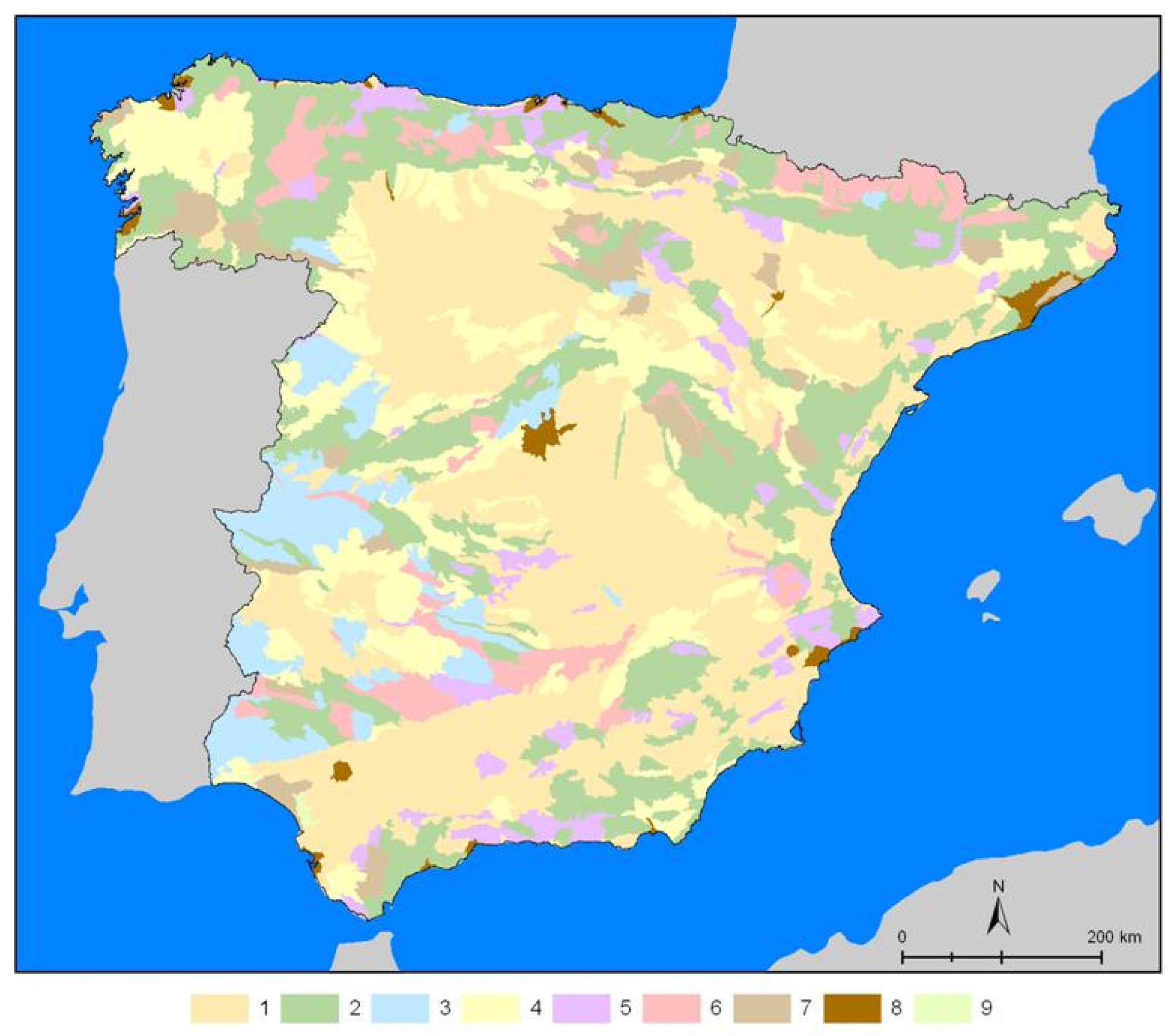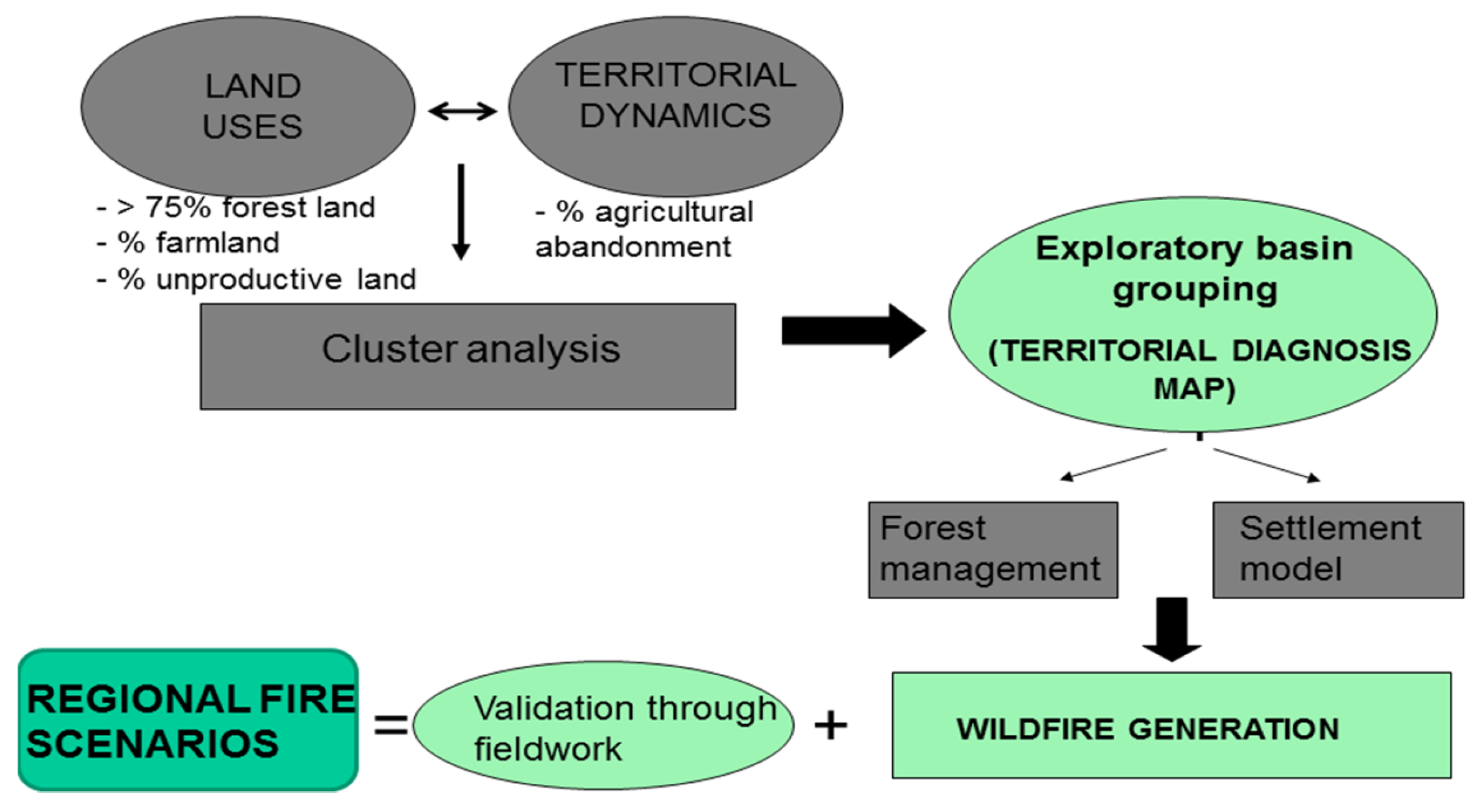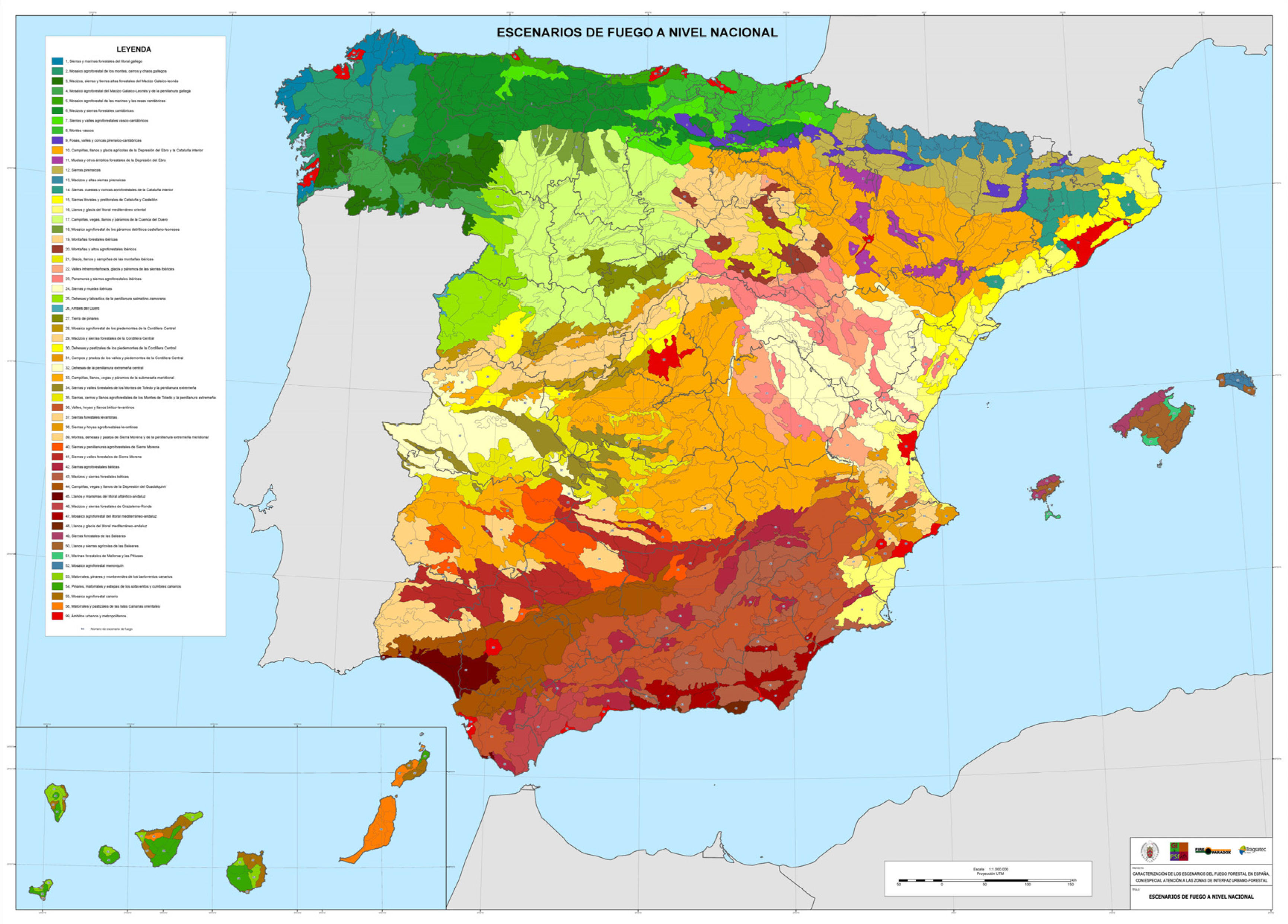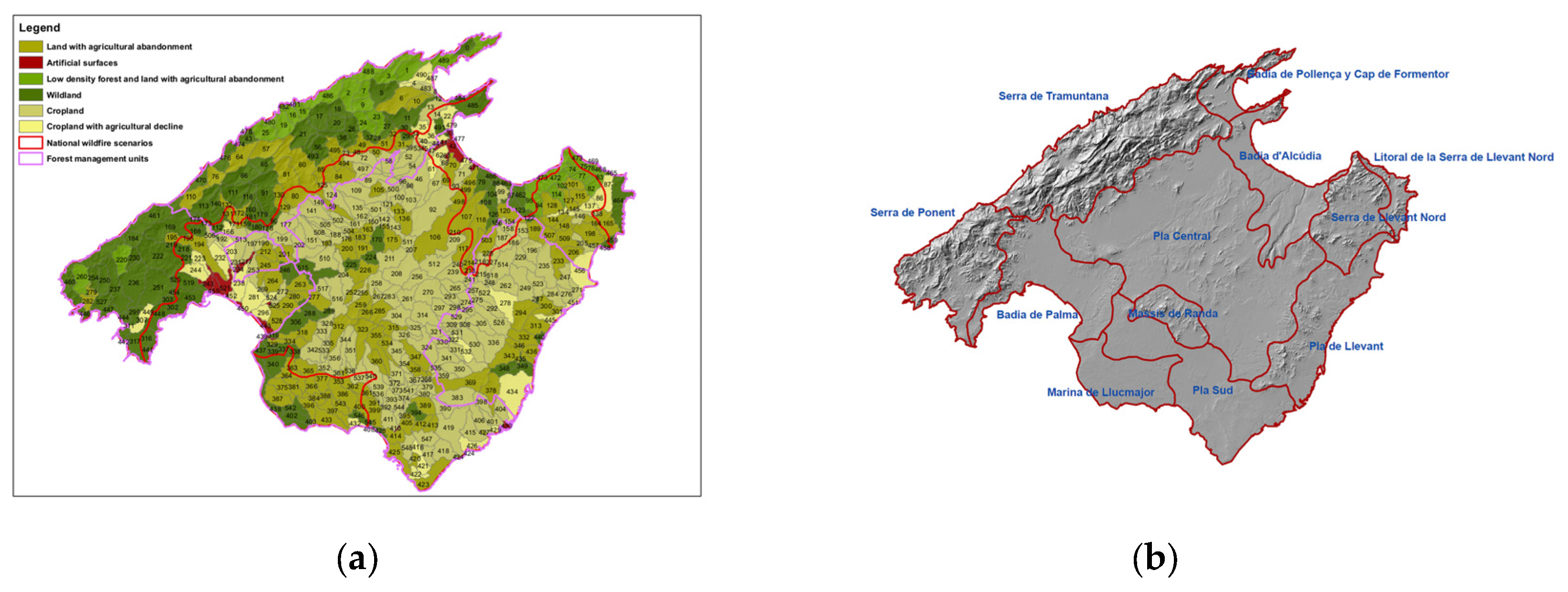Fire Scenarios in Spain: A Territorial Approach to Proactive Fire Management in the Context of Global Change
Abstract
:1. Introduction
2. Materials and Methods
2.1. National Scale
- (1)
- Settlements: Whether there is high or low population is a factor of maximum importance when configuring fire scenarios, as human lives are the top priority for protection in a fire. The information source used in this article is the settlement map (Mapa de Poblamientos) produced by TRAGSATEC from the coverage in Usos del Sistema de Información Geográfica de Parcelas Agrícolas (SIGPAC, 2005), which has been completed with information from the forest map of Spain (Mapa Forestal de España 1:50,000 (MFE50, 2007), both produced by the Spanish Ministry of the Environment (Ministerio de Medio Ambiente y Medio Rural y Marino). By contrasting the data from these two sources using GIS, 9 population/settlement types were obtained depending on type, density and territorial environment (agricultural, forest) (Table 1).
- (2)
- Forest ecosystem propagation hazard: defined as the intrinsic propensity of a forest system to propagate fire and become a wildfire. It is estimated from (i) the fuel and forest vegetation model (determined by the degree of combustibility and flammability) and (ii) the physiography (slope dependent and interpreted through topography).The fuel and forest vegetation model established by Rothermel [32] is used. It has been adapted to Spanish forest systems by the Dirección General de Medio Natural y Política Forestal (MMAMRM), and includes 13 types of fuel models. Models 5, 8, 9, 10, 11, 12 and 13 have been defined as “low combustibility”, and models 1, 2, 3, 4 and 6 as “medium or high combustibility”. On the other hand, the results of the trials carried out in the INIA laboratory to classify plant species flammability have been used to determine which species display high flammability throughout the year or only in summer, which species display moderate or low flammability, and the remaining species [33]. These two variables (combustibility and flammability) are then used to assess the fuel hazard using a decision matrix (Table 2).
- Predominantly agricultural areas with scarce forest presence. Habitats: large, concentrated nuclei. (Countryside, meadows, plains, corridors and intramontane lowlands).
- Predominantly forested areas with high/medium propagation capacity and low agricultural presence, scarcely populated. (Mountain massifs and ranges, south-western peneplains).
- Predominantly forested areas with medium propagation capacity and scarce population (Peneplains and piedmont with dehesa pastureland).
- Agroforest mosaic. Moderate propagation capacity and low population (Sierras and high lands, peneplain environments).
- Agroforest mosaic. High propagation capacity and densely populated (Southern sierras, Cantabrian rias and coastal areas).
- Predominantly forested areas with high/medium propagation capacity and minimum agricultural presence and population. (Sierras and mountain massifs).
- Forested sierras with low/medium propagation capacity.
- Predominantly urban areas.
- Marshland.
2.2. Regional Scale
- Territorial context for vegetation (forest dynamics and agricultural abandonment dynamics): The variables used (proportion of forest, agricultural and non-productive land; proportion of abandoned farmland between 1990 and 2009) are grouped into 6 classes using a cluster analysis for land cover and dynamics. The intensity of agricultural abandonment compared with cultivated land is the main criterion differentiating situations corresponding to the 1st and 2nd generations.
- Interface between forest land and urban area: similarly, the drainage basins belonging to the 4th wildfire generation are identified by the land cover variables (% of urban area, % of dense forest land).
- Forest management: Calculated for each forest type (average values for each landscape unit).
3. Results
3.1. Conceptual and Theoretical Foundation of Fire Scenarios
- -
- National scale: the indicator used is propagation capacity, calculated as a function of flammability and combustibility of forest ecosystems, and slope gradient.
- -
- Regional scale: propagation capacity is evaluated in more detail, by considering forest continuity and structure, as well as the extent of existing agricultural and unproductive land.
- -
- Local scale: the indicators include the degree and continuity of vegetation, and its specific composition and structure, considering in particular the existence of WUI.
- -
- National scale: size and morphology of urban areas and their connection with rural areas.
- -
- Regional scale: density of urban occupancy, as well as the proportion, continuity and density of forested land at the interface between forest and urban areas.
- -
- Local scale: description of WUI and their vulnerability to wildland fires.
3.2. Mapping and Characterization of National Fire Scenarios in Spain
3.3. Testing the Methodology for Identifying the Regional Fire Scenarios: Case Study—The Island of Mallorca
4. Discussion
5. Conclusions
Acknowledgments
Author Contributions
Conflicts of Interest
References
- Keeley, J.E; Bond, W.; Bradstock, R.; Pausas, J.; Rundel, P. Fire in Mediterranean Ecosystems; Cambridge University Press: London, UK, 2012. [Google Scholar]
- Montiel, C.; Herrero, G. Overview of policies and practices related to fire ignitions. In Towards Integrated Fire Management—Outcomes of the European Project Fire Paradox; Silva, S.J., Rego, F., Fernandes, P., Rigolot, E., Eds.; European Forest Institute: Joensuu, Finland, 2010; pp. 35–46. [Google Scholar]
- National Wildfire Coordinating Group. Glossary of Wildland Fire Terminology. 2015. Available online: http://www.nwcg.gov/glossary-of-wildland-fire-terminology (accessed on 27 September 2016). [Google Scholar]
- Viedma, O.; Moity, N.; Moreno, J.M. Changes in landscape fire-hazard during the second half of the 20th century: Agriculture abandonment and the changing role of driving factors. Agric. Ecosyst. Environ. 2015, 217, 126–140. [Google Scholar] [CrossRef]
- Syphard, A.D.; Radeloff, V.; Keeley, J.E.; Hawbaker, T.; Clayton, M.; Stewart, S.; Hammer, R. Human influence on California fire regimes. Ecol. Appl. 2007, 17, 1388–1402. [Google Scholar] [CrossRef] [PubMed]
- Moritz, M.A.; Batllori, E.; Bradstock, R.A.; Gill, A.M.; Handmer, J.; Hessburg, P.F.; Leonard, J.; McCaffrey, S.; Odion, D.C.; Schoennagel, T.; et al. Learning to coexist with wildfire. Nature 2014, 515, 58–66. [Google Scholar] [CrossRef] [PubMed]
- Goldstein, N. Do cities learn from getting burned? In Proceedings of the Artificial Life 7 Workshop, Portland, OR, USA, 1–6 August 2000; Maley, C.C., Boudreau, E., Eds.; pp. 136–138.
- Pausas, J.; Keeley, J.E. A burning story: the role of fire in the history of life. BioScience 2009, 59, 593–601. [Google Scholar] [CrossRef] [Green Version]
- Barros, A.; Pereira, J.M.; Moritz, M.A.; Stephens, S. Spatial characterization of wildfire orientation patterns in California. Foresus 2013, 4, 197–217. [Google Scholar] [CrossRef]
- Castellnou, M.; Larrañaga, A.; Miralles, M.; Molina, D.M. Wildfire scenario: Learning from experience. In Towards Integrated Fire Management—Outcomes of the European Project Fire Paradox; Silva, S.J., Rego, F., Fernandes, P., Rigolot, E., Eds.; European Forest Institute Research Report 23; European Forest Institute: Joensuu, Finland, 2010; pp. 121–133. [Google Scholar]
- Montiel, C.; San Miguel, J. Policy analysis reveals the need for new approaches. In Living with Wildfires: What Science Can Tell Us: A Contribution to the Science-Policy Dialogue; Birot, Y., Ed.; EFI Discussion Paper 15; European Forest Institute: Joensuu, Finland, 2009; pp. 63–67. [Google Scholar]
- Reid, K.; Beilin, R. Where’s the fire? Co-constructing bushfire in the everyday landscape. Soc. Nat. Resour. Int. J. 2014, 27, 140–154. [Google Scholar] [CrossRef]
- Castellnou, M.; Miralles, M.; Pages, J.; Pique, M. Tipificación de los incendios forestales de Cataluña. Elaboración del mapa de incendios de diseño como herramienta para la gestión forestal. In Proceedings of the 5th Congreso Forestal Español, Ávila, Spain, 21–25 September 2009.
- Countryman, C. The Fire Environment Concept; U.S. Department of Agriculture, Forest Service: Berkeley, CA, USA, 1972.
- Raphael, M.; Hessburg, P.F.; Lehmkuhl, H. Assessing the Compatibility of Fuel Treatments, Wildfire Risk and Conservation of Northern Spotted Owl Habitats and Populations in the Eastern Cascades: A Multiscale Analysis; Final Report; JFSP Project 09-1-08-31; University of Nebraska—Lincoln: Lincoln, NE, USA, 2013. [Google Scholar]
- Kruger, T.; Beilin, R. A “responsibility for place”—Firefighter deployment, local knowledge and risk. Int. J. Wildland Fire 2014, 23, 577–584. [Google Scholar] [CrossRef]
- Miller, J.D.; Collins, B.M.; Lutz, J.A.; Stephens, S.L.; van Wagtendonk, J.W.; Yasuda, D.A. Differences in wildfires among ecoregions and land management agencies in the Sierra Nevada region, California. Ecosphere 2012, 3, 1–20. [Google Scholar] [CrossRef]
- Turner, M.; Donato, D.; Romme, W. Consequences of spatial heterogeneity for ecosystem services in changing forest landscapes: Priorities for future research. Landsc. Ecol. 2013, 28, 1081–1097. [Google Scholar] [CrossRef]
- Discroll, D.A.; Bodea, M.; Bradstockd, R.A.; Keithe, D.A.; Penmand, T.D.; Priced, O.F. Resolving future fire management conflicts using multi-criteria decision making. Conserv. Biol. 2015, 30, 196–205. [Google Scholar]
- Beilin, R.; Reid, K. It’s not a “thing” but a “place”: Reconceptualising “assets” in the context of fire risk landscapes. Int. J. Wildland Fire 2015, 24, 130–137. [Google Scholar] [CrossRef]
- Collins, B.; Stephens, S.; Roller, G.; Battles, J. Simulating fire and forest dynamics for a landscape fuel treatment project in the Sierra Nevada. For. Sci. 2011, 57, 77–88. [Google Scholar]
- Linnell, J.; Kaczensky, P.; Wotschikowsky, N.; Lescureux, N.; Boitani, L. Framming the relationship between people and nature in the context of European conservation. Conserv. Biol. 2015, 29, 978–985. [Google Scholar] [CrossRef] [PubMed]
- Mermoz, M.; Kitzberger, T.; Veblen, T.T. Landscape influences on occurrence and spread of wildfires in Patagonian forests and shrublands. Ecology 2005, 86, 2705–2715. [Google Scholar] [CrossRef]
- Stephens, S.L.; McIver, J.D.; Boerner, R.E.J.; Fettig, C.J.; Fontaine, J.B.; Hartsough, B.R.; Kennedy, P.L.; Schwilk, D.W. The effects of forest fuel-reduction treatments in the United States. Biosciences 2012, 62, 549–560. [Google Scholar]
- Chuvieco, E.; Aguado, I.; Jurdao, S.; Pettinari, M.L.; Yebra, M.; Salas, J.; Echeverría, M. Integrating geospatial information into fire risk assessment. Int. J. Wildland Fire 2014, 23, 606–619. [Google Scholar] [CrossRef]
- Rodrigues, M.; De la Riva, J.; Fotheringham, S. Modeling the spatial variation of the explanatory factors of human-caused wildfires in Spain using geographically weighted logistic regression. Appl. Geogr. 2014, 48, 52–63. [Google Scholar] [CrossRef]
- Román, M.V.; Azqueta, D.; Rodrígues, M. Methodological approach to assess the socio-economic vulnerability to wildfires in Spain. For. Ecol. Manag. 2013, 294, 158–165. [Google Scholar] [CrossRef]
- Galiana, L.; Aragoneses, C.; Montiel, C.; de la Cita, J.; Fernández, M. Caracterización de los escenarios del fuego en España. In Proceedings of the 5th Congreso Forestal Español, Ávila, Spain, 21–25 September 2009.
- Galiana, L.; Montiel, C. Landscape changes and wildfire behavior: New fire scenarios in Spain. In Proceedings of the 5th International Wildland Fire Conference, Sun City, South Africa, 9–13 May 2011.
- Costa, P.; Castellnou, M.; Larrañaga, A.; Miralles, M.; Kraus, D. Prevention of Large Wildfires Using the Fire Types Concept; GRAF-Pau Costa Foundation: Barcelona, Spain, 2011. [Google Scholar]
- Wu, J. Effects of changing scale on landscape pattern analysis: Scaling relations. Landsc. Ecol. 2004, 19, 125–138. [Google Scholar] [CrossRef]
- Rothermel, R.C. How to Predict the Spreads and Intensity of Forest and Range Forest Fires; U.S. Department of Agriculture, Forest Service: Ogden, UT, USA, 1983.
- Elvira, L.; Hernando, C. Inflamabilidad y Energı́a de Las Especies de Sotobosque; Instituto Nacional de Investigaciones Agrarias, Ministerio de Agricultura, Pesca y Alimentación: Madrid, Spain, 1989.
- Swanwick, C. Landscape Character Assessment: Guidance for England and Scotland; Countryside Agency and Scottish Natural Heritage: Wetherby, UK, 2002.
- Mata, R.; Sanz, C.; Gómez, J.; Allende, F.; López, N.; Molina, P.; Galiana, L. Atlas de Los Paisajes de España; Ministerio de Medio Ambiente: Madrid, Spain, 2003.
- Martínez-de-Pisón, E.; Molina-Holgado, P. Diversidad del paisaje natural. In La Diversidad Biológica de España; Pineda, F.D., Ed.; Prentice Hall: Madrid, Spain, 2002; pp. 33–44. [Google Scholar]
- Rifà, A.; Castellnou, M. El modelo de extinción de incendios forestales catalán. In Proceedings of the 4th International Wildfire Conference, Sevilla, Spain, 13–18 May 2007.
- Castellnou, M. Nuevas metodologías de prevención de grandes incendios. In Proceedings of the Congreso Forestal Ibérico, Castelo Branco, Portugal, 17–19 December 2000.
- Bahro, B.; Barber, K.H.; Sherlock, J.W.; Yasuda, D.A. Stewardship and fireshed assessment: A process for designing a landscape fuel treatment strategy. Restoring fireadapted ecosystems. In Proceedings of the National Silviculture Workshop: Restoring Fire Adapted Ecosystems, Tahoe City, CA, USA, 6–10 June 2005; Powers, R.F., Ed.; PSW-GTR-203. U.S. Department of Agriculture, Forest Service, Pacific Southwest Research Station: Albany, CA, USA, 2005; pp. 41–54. [Google Scholar]
- Sharples, J.; Gill, M.; Dold, J. The trench effect and eruptive wildfires: Lessons from the King’s Cross Underground disaster. In Proceedings of AFAC 2010 Conference, Darwin, Australia, 8–10 September 2010.
- Valese, E.; Conedera, M.; Held, A.C.; Ascoli, D. Fire, humans and landscape in the European Alpine region during the Holocene. Anthropocene 2014, 6, 63–74. [Google Scholar] [CrossRef]
- Safford, H.D.; Van De Water, K.M. Using Fire Return Interval Departure (FRID) Analysis to Map Spatial and Temporal Changes in Fire Frequency on National Forest Lands in California; Research Paper PSW-RP-266; U.S. Department of Agriculture, Forest Service, Pacific Southwest Research Station: Albany, CA, USA, 2014.
- Galiana, L.; Karlsson, O. Development of a methodology for the assessment of vulnerability related to wildland fires using a multicriteria evaluation. Geogr. Res. 2012, 50, 304–319. [Google Scholar] [CrossRef]





| Settlement Types | Description |
|---|---|
| Urban environment | Urban areas of more than 50 ha |
| Settlement in forest area | Urban nuclei of 1–50 ha or more than 5 urban nuclei of under 1 ha in a 25 m buffer zone. More than 30% of the surrounding surface area (forest and agricultural) in a 1 m buffer zone is forest. |
| Settlement in agricultural area | Urban nuclei of 1–50 ha, or more than 5 urban nuclei of under 1 ha in a 25 m buffer zone. Less than 30% of the surrounding surface area (forest and agricultural) is forest in a 1 m buffer zone. |
| Scattered buildings in forest area | 3–5 urban nuclei of under 1 ha in a 100 m buffer zone. More than 30% of the surrounding surface area (forest and agricultural) in a 1 m buffer zone is forest. |
| Scattered buildings in agricultural area | 3–5 urban nuclei of under 1 ha in a 100 m buffer zone. Less than 30% of the surrounding surface area (forest and agricultural) in a 1 m buffer zone is forest. |
| Isolated buildings in forest area | 1 or 2 urban nuclei of less than 1 ha in a 100 buffer zone. More than 30% of the surrounding surface area (forest and agricultural) in a 1 m buffer zone, is forest. |
| Isolated buildings in agricultural area | 1 or 2 urban nuclei under 1 ha in a 100 m buffer zone. Less than 30% of the surrounding surface area (forest and agricultural) in a 1 m buffer zone is forest. |
| Unpopulated forest area | Forest area with no urban settlements. |
| Unpopulated agricultural area | Agricultural area with no urban settlements. |
| Fuel Hazard | Combustibility | ||
|---|---|---|---|
| Low Combustibility | Medium and High Combustibility | ||
| Flammability | Low flammability | PC1 1 | PC2 2 |
| High flammability | PC2 | PC2 | |
| Physiographic Hazard | Slope Range |
|---|---|
| Low | ≤15% |
| Moderate | 16%–29% |
| High | ≥30% |
| Slope | Fuel Hazard | |
|---|---|---|
| Low | Medium/High | |
| Low | Low | Medium |
| Moderate | Low | High |
| High | Medium | High |
| Wildfire Generation | Fuel | Wildfire Characteristics | Territorial and Temporal Context | Action |
|---|---|---|---|---|
| 1st wildfire generation | Continuity of forest mass, low fuel load (grassland, meadows). | Long perimeters and high propagation speed. | Started in the late 1950–1960s, related to abandoned farmland. | Local response: increased accessibility to the land; linear prevention infrastructure (firebreaks). |
| 2nd wildfire generation | Continuity of forest mass and increased fuel load (scrubland). | High intensity and high propagation speed; start of secondary ignition sites. | Started in the late 1970–1980s due to abandoning of farmland and traditional forest management. | Reduced access time (tracks, quick detection, forceful attack, water spots). |
| 3rd wildfire generation | Homogeneous forests with high densities and vertical continuity. | Crown fires that overwhelm the tactical intervention capacity; multiple secondary ignition sites (advances jumping long distances). Large wildfires, more than 20,000 to 30,000 ha. | Prolonged lack of forest management (30–50 years); extinction of all low- and middle-intensity wildfires. | Extinction task forces admit their limits. Use of all extinction techniques. Strategic response: promotion of forest management and prescribed burnings; promotion of self-protection in estates; advance of opportunities (confinement and deceleration); more dynamic and flexible decision-making. |
| 4th wildfire generation | Same as 3rd + estates with propagation capacity. | Same as 3rd (LWFs) + creation of multiple emergencies (in wildland-urban interfaces (WUI). | Same as 3rd + increase of scattered estates in forest land. | Same as 3rd + differentiation between strategic and tactical levels; decision making at lower levels. |
| 5th wildfire generation | Same as 4th. | Same as 4th + simultaneity. | Same as 4th. | Same as 4th. |
| Defining Elements | Intervening Factors | Sources of Information |
|---|---|---|
| Propagation capacity | Fuel load and continuity Slope | Cartography of fuel models (Forest Map) Digital Terrain Model (DTM) |
| Wildfire characteristics | Intensity, propagation speed, simultaneity Burned area | Wildfire database Wildfire perimeters |
| Territorial context | Agricultural abandonment Intensity of forest management Presence of wildland-urban interface (WUI) | Crops and land use map National Forest Inventory Settlement Map (TRAGSATEC) |
| Driving Forces | Trends and Fire Behavior Effects |
|---|---|
| Ecosystem transition (from grass-fueled to woody-fueled fires) | In non-forested landscapes: Expansion of grass-dominated ecosystems, as a result of agricultural abandonment (higher fire spread: 1st generation of wildland fires) Increase in understory fuels in open forests, as a result of grazing abandonment (higher fire intensity: 2nd generation of wildland fires) In forested landscapes: Increase of shrubland (regeneration of natural vegetation) and development of complex forest ecosystems: increase of fuel load and vertical continuity, as a result of land management abandonment (convective fire-type: 3rd generation) |
| Increase of landscape fuel connectivity | Homogenous surfaces of the same fuel model after traditional landscape mosaic disappears (larger fire perimeters: 1st generation). |
| Urban sprawl | Development of WUI (higher fuel complexity: 4th generation Large and complex urban regions characterized as high risk areas with extremely rapid, virulent fire behavior (simultaneous large wildfires; megafires; 5th generation) |
| Scale | Criteria for Definition of Fire Scenarios | Applied to Planning: Spatial Planning and Rural Development Policies | Applied to Planning : Wildland Fire and Civil Protection Policies |
|---|---|---|---|
| National (1:1,000,000) | General landscape configuration (relief and vegetation cover) Interaction between type of vegetation cover and settlement system. | Characterize and differentiate land areas with regard to fires to enable different region-specific actions. Basis for establishing land development policies including fire risk management. | Establish homogeneous fire prevention and extinction policies in large regional areas. |
| Regional (1:200,000–1:50,000) | Landscape patterns Trends in landscape changes Fire regime | More rational territorial model: to reduce settlement system vulnerability from proliferation of scattered settlements (WUI). Link major decisions on land use to fire regimes. | Spatial basis for appropriate zoning for forest and fire management. |
| Local (1:25,000) | Definition of fire types (interaction of synoptic situations/topography/vegetation type) prone to develop into LWFs in each area | Risk maps: mandatory basis for detailed zoning by use. Management strategies to reduce vulnerability to specific hazards (damage mitigation). | Establish management requirements for specific propagation modes. Pre-extinction actions (defence opportunities; reduction of propagation rate). Mapping of suppression opportunities and priorities. Involvement of general public in fire-related forest management. |
© 2016 by the authors; licensee MDPI, Basel, Switzerland. This article is an open access article distributed under the terms and conditions of the Creative Commons Attribution (CC-BY) license (http://creativecommons.org/licenses/by/4.0/).
Share and Cite
Montiel Molina, C.; Galiana-Martín, L. Fire Scenarios in Spain: A Territorial Approach to Proactive Fire Management in the Context of Global Change. Forests 2016, 7, 273. https://doi.org/10.3390/f7110273
Montiel Molina C, Galiana-Martín L. Fire Scenarios in Spain: A Territorial Approach to Proactive Fire Management in the Context of Global Change. Forests. 2016; 7(11):273. https://doi.org/10.3390/f7110273
Chicago/Turabian StyleMontiel Molina, Cristina, and Luis Galiana-Martín. 2016. "Fire Scenarios in Spain: A Territorial Approach to Proactive Fire Management in the Context of Global Change" Forests 7, no. 11: 273. https://doi.org/10.3390/f7110273







